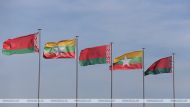
GOHEUNG, 27 November (BelTA - Yonhap) - South Korea on Thursday
confirmed the successful launch of its homegrown space rocket Nuri,
which took off from Naro Space Center, with the main unit of the 13
satellites deployed establishing communication with King Sejong Station
in Antarctica.
The 200-ton Nuri blasted off from the center in the country's southern coastal village of Goheung, some 330 kilometers south of Seoul, at 1:13 a.m., slightly behind the original plan of 12:55 a.m. due to a sensor issue.
According to the KASA and the Korea Aerospace Research Institute (KARI), the main satellite, CAS500-3, made communication with South Korea's research center in Antarctica at 1:55 a.m., allowing experts to check the unit's condition.
"The fourth launch of Nuri was successful," Science Minister Bae Kyung-hoon said during a press briefing at the center, noting all satellites have been put into orbit.
"This was an important turning point in which the focus of the space ecosystem shifted to the private sector from the previous government-oriented approach," Bae added, noting the government will make efforts to become one of the world's top five space powerhouses in an unwavering manner.
The 200-ton Nuri blasted off from the center in the country's southern coastal village of Goheung, some 330 kilometers south of Seoul, at 1:13 a.m., slightly behind the original plan of 12:55 a.m. due to a sensor issue.
According to the KASA and the Korea Aerospace Research Institute (KARI), the main satellite, CAS500-3, made communication with South Korea's research center in Antarctica at 1:55 a.m., allowing experts to check the unit's condition.
"The fourth launch of Nuri was successful," Science Minister Bae Kyung-hoon said during a press briefing at the center, noting all satellites have been put into orbit.
"This was an important turning point in which the focus of the space ecosystem shifted to the private sector from the previous government-oriented approach," Bae added, noting the government will make efforts to become one of the world's top five space powerhouses in an unwavering manner.













